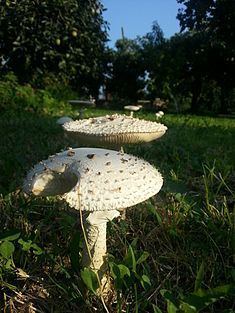Kingdom Fungi Class Agaricomycetes Order Agaricales | Division Basidiomycota | |
 | ||
Genus SaproamanitaRedhead, Vizzini, Drehmel & Contu (2016) Similar Amanita nauseosa, Amanita ochrophylloides, Amanita pekeoides, Amanita nehuta, Amanita ravenelii | ||
The genus Saproamanita contains about 23 species of agarics and is one of four genera in the family Amanitaceae. The others are Amanita (which now includes the synonym Torrendia), Limacella, and Catatrama. Saproamanita are the saprophytic species in the Tribe Amaniteae separately classified from the ectomycorrhizal species in the genus Amanita.
Contents
Saproamanita resemble Amanita and have a pileus, free lamellae, a central stipe, and an annulus with scales and rings below the annulus that are the remnants of the universal veil composed largely of cylindrical to slender clavate inflated hyphal cells mostly scattered in the central stipe region rather than the base. The spores are white and amyloid. DNA molecular evidence for the separation of the saprotrophic genus from the sister genus of symbiotic genus Amanita was first detected in a study of mushrooms and their families in 2002 when Saproamanita armillariiformis [under the name Amanita armillariiformis] appeared basal to Amanita. Later studies supported by larger samplings of species and additional gene regions in investigations of the family Amanitaceae expanded the sampling of both groups of species that were all considered to be Amanita species or separated into two genera under the names Aspidella and Amanita. In the most detailed study of decomposition pathway enzymes that supports taxonomic separation, the subgeneric name Amanita subgen. Lepidella was applied to a group of species that did not include the type species of the subgenus. That group is correctly named Amanita subgen. Amanitina.
Saproamanita are known to inhabit grasslands, lawns, pastures, fens, and fields in Africa, Asia, Australia, Europe, North America, the Caribbean, and South America as well as glens in open canopy forests. Some species are known to form fairy rings. At least two of the species are invasive species expanding their ranges, S. inopinata in Europe and S. thiersii in North America.
Taxonomy
The name refers to the saprotrophic life style and the generic relationship to its sister genus Amanita. In earlier studies the genus was ill defined and named Lepidella and later Aspidella. Both of these names are unusable because of earlier usage by biologists for other organisms, e.g. Aspidella E. Billings. The most recent adoption of the name Aspidella was based on a molecularly and ecologically defined genus similar to the current circumscription.
Currently there are two competing contemporary classifications, one that recognizes the two genera, Amanita and Saproamanita, and the other that maintains both genera under the older name Amanita.<http://www.amanitaceae.org/>
Genome Sequencing
The genome of Saproamanita thiersii (as Amanita thiersii) and its cellulose degrading capability are the subject of a US Department of Energy, Joint Genome Institute project.
